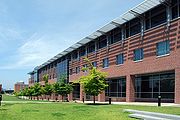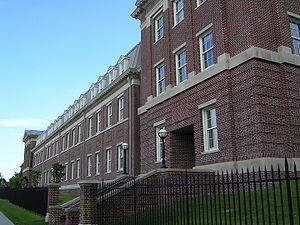
Center for Biotechnology and Interdisciplinary Studies
Encyclopedia

Rensselaer Polytechnic Institute
Stephen Van Rensselaer established the Rensselaer School on November 5, 1824 with a letter to the Rev. Dr. Samuel Blatchford, in which van Rensselaer asked Blatchford to serve as the first president. Within the letter he set down several orders of business. He appointed Amos Eaton as the school's...
(RPI). The 218000 square feet (20,252.9 m²) building is located on 15th street between RPI’s Playhouse and Academy Hall, next to the Center for Industrial Innovation. The institute hopes the new facility will help to encourage collaboration between experts in different fields, allowing them to solve problems that they would be unable to solve alone. As of 2008, the director of the center is Jonathan Dordick
Jonathan Dordick
Jonathan S. Dordick is the Howard P. Isermann Professor of Biochemical Engineering at Rensselaer Polytechnic Institute. In 2008 he became director of the Center for Biotechnology and Interdisciplinary Studies.-Background:...
.
Construction and architecture
Ground was broken on May 17, 2002 for the Center for Biotechnology and Interdisciplinary Studies as part of the Rensselaer Plan, a $400 million campus improvement project.Much of the plan was made possible by a $130 million anonymous donation in December 2000 Construction lasted through September 2004 when the building officially opened. However, researchers did not begin to use the new facilities until well into the fall 2004 semester.Early in 2001, Burt Hill Kosar Rittelmann of Butler, PA and Bohlin Cywinski Jackson of Pittsburgh, PA were chosen by Rensselaer as the architecture
Architecture
Architecture is both the process and product of planning, designing and construction. Architectural works, in the material form of buildings, are often perceived as cultural and political symbols and as works of art...
firms to handle the design of the structure Board chairman of Burt Hill Kosar Rittelmann Associates, Richard Rittelmann who obtained an architecture degree from RPI in 1960, was chosen to lead the project. Rittelmann was chosen for the project as his firm was a national leader in the design of research and biotechnology buildings. During the project, twelve students participated in a two credit course called “Tracking the Biotechnology Center,” a course designed for civil engineering
Civil engineering
Civil engineering is a professional engineering discipline that deals with the design, construction, and maintenance of the physical and naturally built environment, including works like roads, bridges, canals, dams, and buildings...
and architecture students. Mark Mistur, an associate professor of architecture, along with Rittelmann designed the course thinking it “would be a wonderful opportunity for students to see the whole process, including the struggles and successes that result when architects and engineers work together.” The course brought students through the entire process of constructing a building. Topics of the course included everything from the physical construction and design processes of the building to the legal issues associated with such a large project.
The Biotechnology Center is from what appears to be, from the inside, two separate L-shaped buildings. The first of these “buildings” is a group of offices with one three story wing facing 15th Street and another four story wing facing College Ave. The second “building” is a four story section of laboratories that run adjacent to the Center for Industrial Innovation. A large glass atrium separates the two sections. Elevated walkways allow researchers to pass from their offices across the atrium to their laboratories. This is done because laboratory space is very expensive to build and has strict code requirements. Separating the spaces allows for a more cost effective design.
Along with cost effectiveness, the building was also designed with energy efficiency in mind. The large atrium, which gives light to much of the building, requires no heating in the winter, and no cooling in the summer. Natural ventilation is obtained though a series of soffit
Soffit
Soffit , in architecture, describes the underside of any construction element...
vents. Laboratories include heat recovery systems to trap heat and incorporate the most energy efficient lighting
In an effort to blend the new facility with its historical surroundings, the 15th Street façade was designed to match the red brick construction of the Quadrangle residence hall. On the South face of the building a more contemporary style is used, as there are fewer building styles for it to clash with. This side of the building showcases the glass atrium and includes a large open grass area with walkways, benches, and outdoor lighting.
Building features and facilities

The Biotechnology Center contains three different types of laboratory spaces to complement each other. The three types are Research, Support and Core Laboratories. Research Laboratories are designed to be flexible. These laboratories were designed in a way so they could be used for almost any type of research activities. Support Laboratories are less flexible than the Research Laboratories but contain special equipment such as a mass spectrometer. Core Laboratories often contain special equipment not available anywhere else in the facility.
Some core facilities found at the Biotechnology Center
- Nuclear Magnetic ResonanceNuclear magnetic resonanceNuclear magnetic resonance is a physical phenomenon in which magnetic nuclei in a magnetic field absorb and re-emit electromagnetic radiation...
(NMR) Core Facility :home to two Bunker NMR spectrometers, a 800 MHz (18.8 teslas) and 600 MHz (14.1 teslas), used to determine molecular structure. - Biacore 3000 Surface Plasmon ResonanceSurface plasmon resonanceThe excitation of surface plasmons by light is denoted as a surface plasmon resonance for planar surfaces or localized surface plasmon resonance for nanometer-sized metallic structures....
(SPR) Spectrometer:a facility using SPR to measure biomolecular interactions. - Zebrafish Facility: a 385 square foot (36 m²) room containing two holding systems for the fish. Each holding system controls the water purity and pH and has a capacity of 10,350 adult fish.
- Microscopy and Imaging:this facility contains numerous state of the art microscopes and flow cytometer instruments.

